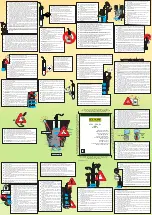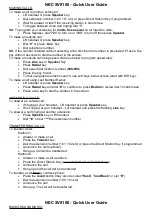
AFW RO System Manual
[14]
Revised 9/09
©Abundant Flow Water System, Inc. 2009
membrane is producing go to VI.
VI.
Check the blue line connecting the auto shut off valve to the inline post filter (or the UV filter if
equipped). Flow here should be the same as in the last step. If it not, the auto shut off valve is
defective and needs to be replaced. Check the flow after the UV filter if equipped, if flow is
less, there is a blockage in the UV housing. If flow is fine, go to VII.
VII.
Remove the T-fitting from the outlet side of the post filter (the one connected to the “A” and
“B” valves). Flow from the post filter should be the same as the last step. If not, your post filter
is clogged and needs replaced. If flow is fine and the system is in bypass mode go to VIII. If
the system is NOT in bypass mode go to IX.
VIII.
Ensure the line running to the faucet is not clogged or damaged, and check the faucet for
obstructions.
IX.
Check the flow after the 3
rd
filter housing, flow should be the same as it was coming out of the
post filter. If not, ensure there are no obstructions in the lines between the post filter an DI
filter or in the DI housing. If there are none, replace the DI filter. If flow is fine, ensure the line
running to the faucet is not clogged or damaged, and check the faucet for obstructions.
Waste Water Not Shutting Off
1.
Make sure pre-filters are clean, dirty filters reduce pressure to the membrane, which decreases
output pressure. If you system is not providing enough pressure through the membrane, the
auto shut off valve will not activate and waste water will continue to flow. Check the water flow
before and after the pre-filters. If water flow after the pre-filters is reduced the filters are dirty
and need replaced.
2.
Ensure water supply is fully opened, and that there are no kinks in the lines. Check all valves to
make sure they are open fully. Check for leaks and ensure there are no obstructions in the line.
Check water flow before and after the auto shut off valve (the white square block behind the
membrane), flow should be the same, if it is not, your auto shut off valve is defective, replace it.
3.
Verify that the valve on the flow restrictor is in the CLOSED position. If open, pressure will not
build up and the system will not shut off.
4.
Ensure you have enough pressure. The RO process requires a minimum of 40psi, if your
pressure is less you will need a booster pump.
5.
Shut the valve on the tank off. If the problem persists with the tank off, your check valve or auto
shut off valve is defective. We recommend replacing the check valve first, as it tends to be the
problem more often than the auto shut off valve. If replacing the check valve doesn't solve the
problem, replace the auto shut off valve.




































